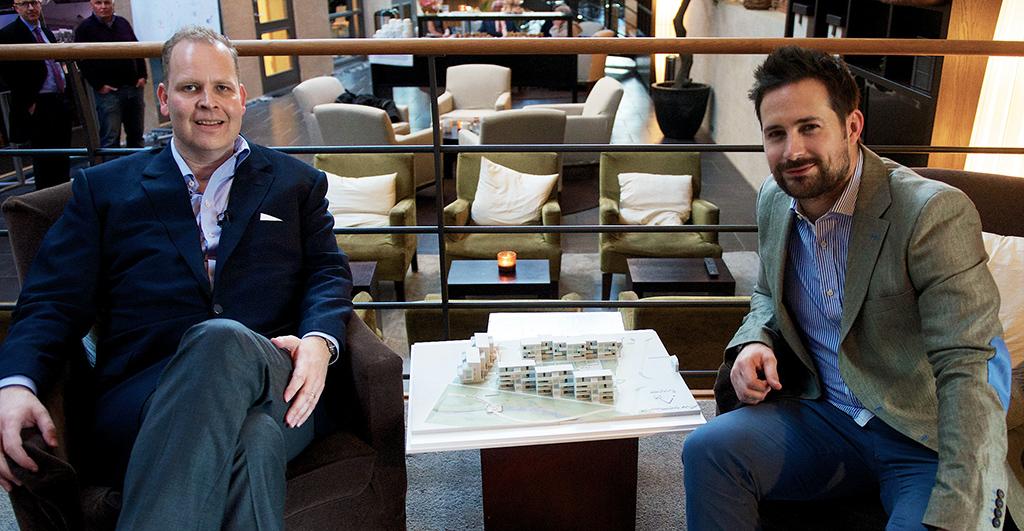London-based architect, David Weatherhead of Weatherhead Architecture, Ltd., was formerly a skeptic of the benefits of 3D printing in the architectural design process. He regarded model-making as a necessary step but one typically outsourced to professional model makers to save time. When Weatherhead began running his own practice, he admits he had to rethink his approach on many fronts. “I had to evolve my skills,” he wrote in a recent blog. “With time always escaping me, the decision was made to explore technology and see what it can do for me.”
Weatherhead decided to try 3D printing of a model for a housing project his firm designed in Sweden called Skummeslövs Ängar. The scale he selected for the model was 1:250, which he regards as “kind of in-between being detailed and concept.”
To create his 3D-printed model from his design, produced in ArchiCAD, Weatherhead engaged Hobs Studio in London. Hobs offered him two different 3D-printing options. According to Weatherhead, the first involved, “a layering system using fine powder. The plan shape builds up through 1mm printed layers.” Weatherhead felt this process produced a model that was not as refined as he preferred. The second process, explained Weatherhead, entailed “a clear liquid bath and some lasers.” In essence, he continued, “the lasers solidify the area that needs it, and the model literally rises up from the liquid over time.” The drawback with this process for Weatherhead was that the resulting model was clear, although  smoother than the first material. Both processes were priced nearly identically. After weighing his options, the architect decided on the first process and the cost was within his firm’s budget.
smoother than the first material. Both processes were priced nearly identically. After weighing his options, the architect decided on the first process and the cost was within his firm’s budget.
Weatherhead ran into a problem because he had an outdated version of ArchiCAD. After updating to ArchiCAD 17, which allowed him to provide Hobs Studio with an .STL file, the project moved forward and Hobs responded quickly with a screen shot of the converted model.
The next snag, for Weatherhead, was that the 3D-printing process at the scale he desired would make it impossible to print a simulation of glass. Hobs offered to print areas that were designated as glass in color, as the model would have been too delicate with those spaces simply left open. The architect feared that the colored effect would produce a model that looked, in his words, like a “toy town,” an end result he balked at.
Weatherhead opted to produce a test print, which he offered to pay for out-of-pocket. In a gesture of goodwill (and astute salesmanship), Hobs printed one element of the model in color. In the end, a kind of compromise was reached and the model was printed with the glassed-in areas open, literally–explained Weatherhead, “Since the model was going to be printed with the glass solid I decided to open up as many of the glass sliding doors as possible to further give the impression that these elements are glass.” He also adjusted the design so that he could “show interior furniture,” an extra step that was actually quite simple.
With the problem of the buildings–particularly, the windows–resolved, Weatherhead adjusted his design to add color to the landscape, providing details such as shrubs, plants, and flowers. He described this fairly simple step, “I then worked on this in Photoshop and muted the color a little. I removed the background and saved [the file] as a transparent .png file. I then sent this, at the right scale, to Hobs and they added the changes to the virtual model.” Hobs refined the final model, which included deleting any excess material to reduce cost.
Weatherhead was surprised to discover that it took “less than a day” for Hobs Studio to print the final, 3D model. He also requested a display case and a case for transporting the model to Sweden. Ultimately, the architect was happy with the end result, although he would alter the finished model’s windows. He admitted in his blog that he was now embracing this new process for creating 3d models, writing, “I’m also really happy I didn’t spend a solid day cutting 2D sections and elevations and spending time explaining the contours of the landscape…So many times I have had models made and you receive [them] only to discover loads of things which were lost in translation. As an architect, I hate this more than anything; it’s a bit like picking up the wrong baby from the hospital.”
Subscribe to Our Email Newsletter
Stay up-to-date on all the latest news from the 3D printing industry and receive information and offers from third party vendors.
You May Also Like
3D Printing Unpeeled: New Arkema Material for HP, Saddle and Macro MEMS
A new Arkema material for MJF is said to reduce costs per part by up to 25% and have an 85% reusability ratio. HP 3D HR PA 12 S has been...
3D Printing News Briefs, January 20, 2024: FDM, LPBF, Underwater 3D Printer, Racing, & More
We’re starting off with a process certification in today’s 3D Printing News Briefs, and then moving on to research about solute trapping, laser powder bed fusion, and then moving on...
3D Printing Webinar and Event Roundup: December 3, 2023
We’ve got plenty of events and webinars coming up for you this week! Quickparts is having a Manufacturing Roadshow, America Makes is holding a Member Town Hall, Stratafest makes two...
Intuitive Machines Debuts $40M Hub for Lunar Ambitions and 3D Printing Tech
Best known for its pioneering work in lunar exploration and its development of the Nova-C lunar lander, Intuitive Machines (Nasdaq: LUNR) has marked yet another significant milestone. The leading space...

































